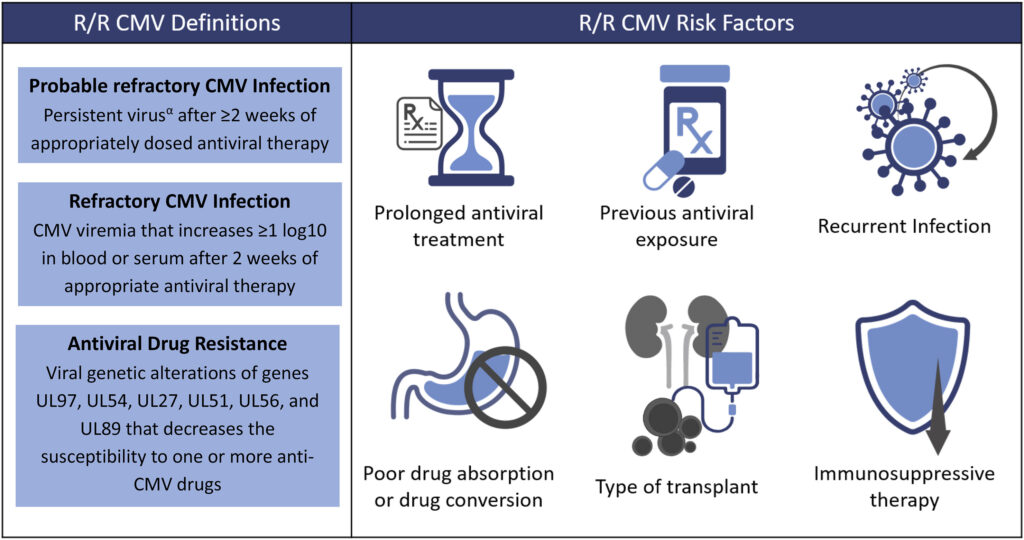Cytomegalovirus (CMV) is a major cause of infectious complications following solid organ transplantation. Its presence not only results in direct effects—such as CMV syndrome and tissue-invasive disease—but also exerts indirect effects, including allograft rejection, opportunistic infections, and long-term graft dysfunction. The prevention of CMV disease after organ transplant must be proactive, risk-adapted, and supported by robust diagnostic and therapeutic measures to ensure optimal post-transplant outcomes.

Risk-Based Stratification: Foundation for CMV Prevention
Determining the CMV serostatus of donor and recipient is central to identifying the risk of post-transplant CMV infection.
| Donor Serostatus | Recipient Serostatus | CMV Risk Level |
|---|---|---|
| Positive (D+) | Negative (R−) | High |
| Positive (D+) | Positive (R+) | Intermediate |
| Negative (D−) | Positive (R+) | Intermediate |
| Negative (D−) | Negative (R−) | Low |
- D+/R− patients are at highest risk due to lack of prior immunity and viral exposure through the graft.
- D+/R+ and D−/R+ represent reactivation or reinfection scenarios.
- D−/R− patients are typically at minimal risk and rarely require prophylaxis.
Antiviral Prophylaxis: A Core Strategy Against CMV
Valganciclovir: First-Line Prophylactic Agent
- Indication: Universal prophylaxis for high and intermediate-risk transplant recipients.
- Standard Dose: 900 mg orally once daily (adjusted for renal function).
- Duration:
- High risk (D+/R−): 6 months
- Intermediate risk (D+/R+, D−/R+): 3 months
Valganciclovir reduces the incidence of CMV syndrome, tissue-invasive disease, and downstream complications such as graft rejection.
Ganciclovir IV
- Administered in hospitalized or gastrointestinal-compromised patients.
- Dose: 5 mg/kg IV every 12 hours during induction, adjusted per renal clearance.
- Often used during initial high-risk post-operative periods.
Preemptive Therapy: An Effective Alternative in Selected Populations
Preemptive therapy hinges on regular monitoring of CMV viremia and the initiation of antiviral treatment when early viral replication is detected—prior to the onset of clinical symptoms.
Implementation Protocol
- CMV PCR Testing: Weekly for first 3–4 months post-transplant.
- Threshold for Treatment: CMV viral load >1000 IU/mL or rising trend (institution-dependent).
- Treatment: Valganciclovir 900 mg BID until two consecutive negative CMV PCRs.
Preemptive therapy is particularly suitable for intermediate-risk recipients or in settings with strong laboratory and clinical follow-up infrastructure.
Surveillance Strategies for Early CMV Detection
Quantitative CMV PCR Monitoring
- Gold standard for detecting subclinical viremia.
- Essential for preemptive therapy and post-prophylaxis monitoring.
- Guides treatment timing and duration.
CMV-Specific Cell-Mediated Immunity Assays
- QuantiFERON-CMV or ELISPOT to assess recipient’s immune response.
- Helps predict susceptibility to CMV reactivation.
- Valuable for personalized prophylaxis duration and stopping decisions.
Managing Immunosuppression to Reduce CMV Susceptibility
CMV disease incidence is closely linked to the intensity of immunosuppression administered post-transplant. Reducing immunosuppressive exposure when possible may diminish CMV risk.
Contributing Factors
- Depleting agents (e.g., ATG, alemtuzumab) elevate risk substantially.
- Use of mycophenolate mofetil increases CMV susceptibility.
- Tailoring immunosuppression with steroid-sparing protocols can reduce CMV incidence.
Post-Prophylaxis Management and Late-Onset CMV Disease
CMV disease often emerges after cessation of prophylaxis, particularly in high-risk patients. Monitoring beyond the prophylaxis period is crucial.
Recommendations
- Post-prophylaxis CMV PCR surveillance: Monthly for 3 months.
- Consider extended prophylaxis (up to 200 days) in D+/R− or those on T-cell depleting agents.
- Immune monitoring may aid in determining safe timing for prophylaxis discontinuation.
Emerging Therapies and Alternative Approaches
Letermovir
- Inhibits the CMV terminase complex.
- Approved for CMV prophylaxis in hematopoietic cell transplants.
- Off-label application in solid organ transplant recipients is under investigation.
- Suitable for patients with valganciclovir intolerance or resistance.
CMV Immunoglobulin (CMV-IVIG)
- Used as adjunctive therapy in severe or recurrent CMV cases.
- May provide benefit in high-risk D+/R− recipients or after CMV disease resolution.
Frequently Asked Questions
What organs are most at risk for CMV after transplant?
- Lung and small bowel transplants carry the highest CMV disease risk due to intense immunosuppression.
- Kidney, liver, and heart transplants have moderate CMV risk, managed effectively with prophylaxis.
Can CMV disease cause graft failure?
Yes. CMV can trigger allograft inflammation, acute rejection, and chronic dysfunction, significantly impacting graft survival.
How long should CMV prophylaxis last?
- High-risk (D+/R−): 6 months or longer
- Intermediate-risk: 3 months
- Tailored based on immune monitoring and post-prophylaxis PCR
What are signs of CMV disease?
- Fever, malaise, leukopenia
- Gastrointestinal symptoms (diarrhea, colitis)
- Pneumonitis, hepatitis, or retinitis in tissue-invasive disease
Is preemptive therapy safe?
Yes. In controlled settings with consistent monitoring, preemptive therapy is safe and effective, particularly in intermediate-risk patients.
An effective strategy for the prevention of CMV disease after organ transplantation must integrate individual risk assessment, appropriate use of antiviral prophylaxis, surveillance-based preemptive therapy, and immune function monitoring. High-risk patients benefit from prolonged prophylaxis and post-treatment vigilance, while advances such as Letermovir and CMV-specific immunity assays offer promising tools for individualized patient care. A multi-disciplinary, evidence-based approach remains vital to improving transplant success and minimizing CMV-related complications.